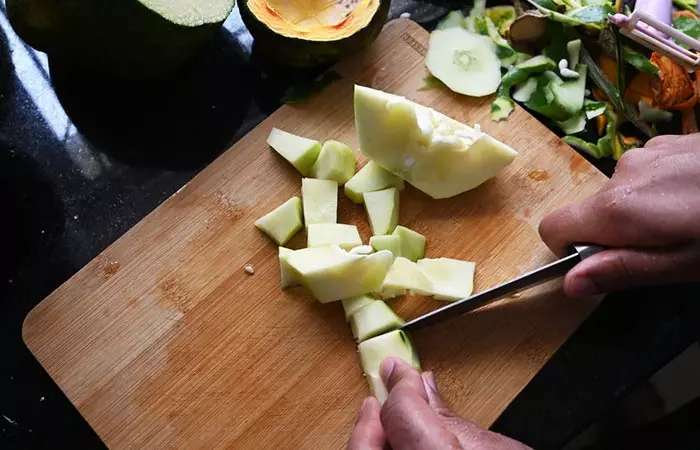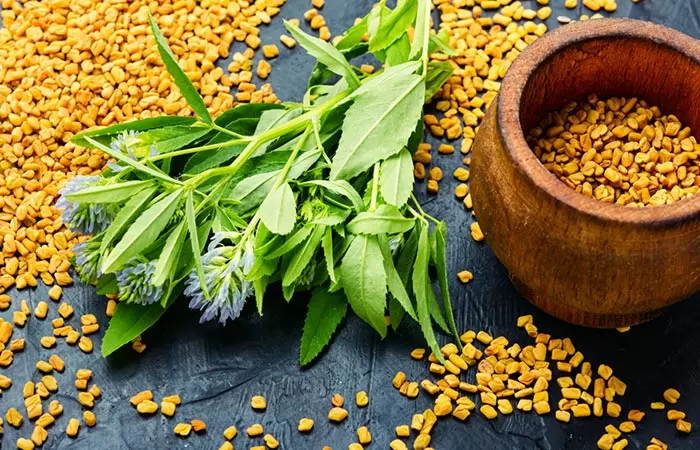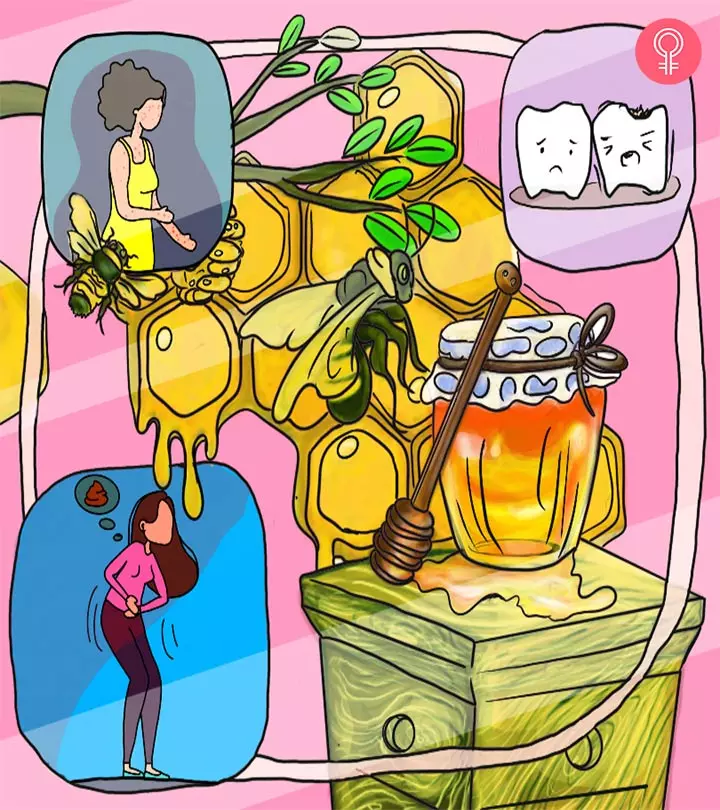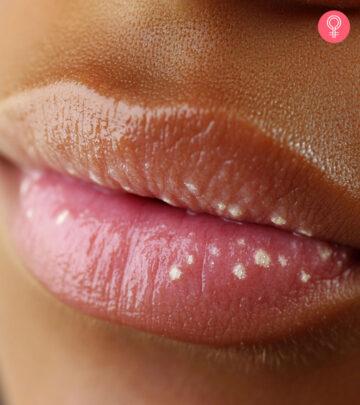Dysentery Home Remedies: 12 Natural Ways To Soothe Symptoms
Identify the signs and treat this medical emergency caused by contaminated food or water.

Image: Shutterstock

Dysentery is one of the most prevalent gastrointestinal problems. According to studies, an estimated 165 million individuals worldwide are infected with bacillary dysentery, and 1.1 million people die each year due to the condition (1). You should start with home remedies for dysentery as soon as you suspect that you have the condition, as it may take away crucial time before you can get a doctor’s appointment. Dysentery may result in death if not treated promptly and adequately. So, it is critical to intervene as early as possible.
This article discusses the causes of dysentery, natural ways to relieve the symptoms, and ways to avoid it. Keep reading!
In This Article
What Is Dysentery?
Dysentery is a digestive problem characterized by loose and watery stool containing blood.
It is accompanied by intestinal inflammation and stomach cramps. It can cause discomfort for a few hours or days. However, in some cases, it is known to last longer.
 Did You Know?
Did You Know?Dysenteric syndrome may be caused by shigella bacteria (shigellosis) and ameba. Bacillary dysentery is mild, while amebic dysentery is mostly severe and requires immediate medical intervention. Patients typically contract two types of dysentery. They are discussed below.
Key Takeaways
- Increase fluid intake to keep yourself hydrated.
- Take up the BRAT diet (bananas, rice, applesauce, and toast).
- Consume probiotic foods to improve gut health.
- Soothe the discomfort and inflammation with medicinal herbs like fenugreek, ginger, and chamomile.
- Dysentery can sometimes even be confused with proctitis as they both include similar symptoms, such as bloody stool and abdominal discomfort.
Types Of Dysentery
- Acute Dysentery: Acute dysentery lasts for less than two weeks or 14 days. It is characterized by abdominal pain and loose motions. In rare cases, pus is observed in the stools.
- Chronic Dysentery: Chronic dysentery lasts for more than 30 days. If acute dysentery is not treated on time, it can turn chronic. The general health of the individual gets disturbed, and it can prove to be dangerous in the long run.
Some complications of dysentery are postinfectious arthritisi A condition that causes inflammation and stiffness in the joints. It is painful and worsens in old age. , generalized seizures, and hemolysisi The breakdown of red blood cells that causes the release of hemoglobin from cells into the blood plasma. of red cells due to antibody formation. Amoebic dysentery may cause a liver abscess, which requires prolonged medical treatment and hospitalization for drainage.
How Does Dysentery Spread?
Dysentery typically spreads as a result of poor sanitary conditions and habits. The infection spreads through contact with food or water that has been contaminated with excreta.
Shigellosis (bacterial dysentery) is spread through close contact with an infected person and infection with contaminated food and drinks. Amoebic dysentery is primarily spread by eating contaminated food or drinking contaminated water in tropical areas that have poor sanitation.
What Causes Dysentery?
Dysentery is caused by Shigella bacteria or an ameba called Entamoeba histolytica. The most common cause of dysentery is poor sanitary conditions. Stale food, contaminated water, and exposure to human excreta are other causes of dysentery (2).
People living in overcrowded areas with poor standards of sanitation and regions of tropical climate are susceptible to contaminated food and water. This forms an easy channel for one to catch an infection that can cause dysentery. This infection can also be transferred through carriers, such as house flies, water, or food, and, in some cases, physical contact with another person carrying the infection (3).
What Are The Symptoms Of Dysentery?
- Abdominal pain
- Loose motions and tenesmus (the urge to empty the bowels)
- Dehydration
- Nausea and vomiting
- Fever
- Convulsionsi An abrupt, uncontrollable movement of your body's muscles brought on by disease or medication. (in rare cases) (4).
How Is Dysentery Diagnosed?
Dysentery can cause severe dehydration. Hence, it is imperative that you consult your doctor at the earliest. This condition can become potentially life-threatening if left untreated.
You will be asked if you traveled recently. Any travels out of the country can help your doctor determine the cause of dysentery. Since there are many factors that can cause dysentery, you might be asked to undergo a blood and stool test that can help determine the presence of bacteria. Depending on the results, you will be prescribed a course of antibiotics to eliminate the bacterial infection.
Dysentery OTC Treatment
There are several OTC medication options to help treat dysentery:
- Bismuth subsalicylate (known as Pepto-Bismol) has an antisecretoryi A drug that lowers a body fluid's normal secretion rate, generally one that lowers stomach acid production. effect on the digestive system (5). It can help relieve cramps and reduce frequent bowel movements. Avoid taking medicines like Loperamide that decrease peristalsis or bowel movement and can aggravate your condition (6).
- Your doctor will prescribe a dose of antibiotics if you have a severe case of shigellosis.
- The most important aspect of dysentery is to take care of dehydration. You can get oral rehydration solutions (ORS) and oral fluids as they can replenish the loss of water and electrolytes like sodium and potassium (7).
- If you have amebic dysentery, you will be advised to take metronidazole or tinidazole that have antiprotozoali A drug used to treat infections caused by protozoa which eliminates or hampers their capacity to develop and reproduce. activity and can help fight the infection caused by Entamoeba histolytica (8), (9).
In the case of severe dysentery, your doctor may suggest an intravenous (IV) drip to prevent dehydration.
Let’s take a look at home remedies to manage dysentery. These may help in mild to moderate cases of dysentery. However, in severe cases, it is recommended to seek medical intervention.
Natural Ways To Manage Dysentery
1. Orange Juice

Orange juice contains flavonoids that exhibit anti-inflammatory properties (10). These properties may help soothe the intestinal lining and also keep you hydrated.
You Will Need
Orange juice
What You Have To Do
Drink this throughout the day.
How Often You Should Do This
You may drink up to 3-4 glasses of orange juice during the day.
Note: Consuming orange juice can increase the level of sugar in your blood. You can regulate this by having freshly squeezed orange juice.
2. Buttermilk
Buttermilk
contains probiotics or good bacteria. Probiotics promote digestion by maintaining the balance of good and bad bacteria in the digestive system (11). They may also help shorten the duration of the infection (12). Avoid this remedy if you are lactose-intolerant.
A lifestyle blogger wrote how consuming buttermilk helped improve her stomach issues. She said, “Whenever I complain about stomach pains or stomach upsets, my father-in-law used to making this spicy buttermilk which will ease my problems in a couple of hours (i).”
You Will Need
Buttermilk
What You Have To Do
Drink buttermilk all through the day.
How Often You Should Do This
Drink up to 3-4 glasses during the day.
3. Raw Papaya

Research shows that papaya can help reduce stomach cramps and promote regular bowel movement (13). It is known to relieve digestive and abdominal issues and may also help alleviate the symptoms of dysentery.
You Will Need
- 1 raw papaya
- 3-4 cups of water
What You Have To Do
- Peel the raw papaya and grate it. Boil it in water for 10-15 minutes.
- Strain the liquid and consume it while it is warm.
How Often You Should Do This
Drink this 2-3 times a day.
Note: Overconsumption of papaya may result in stomach irritation as it has a mild laxative effect and can aggravate the symptoms. Hence, limit your consumption.
4. Terminalia Chebula (Haritaki)
Terminalia Chebula is an herb that exhibits antibacterial properties (14). This may help alleviate infection associated with dysentery and provide relief.
You Will Need
- 1/2 teaspoon of Terminalia chebula (haritaki) powder
- 1 glass lukewarm water
What You Have To Do
Consume Terminalia chebula (Haritaki) before going to sleep. Check with an Ayurvedic practitioner before you do so.
How Often You Should Do This
Repeat every night until you feel better.
Note: Do not consume excessive amounts of this herb as it may aggravate your condition.
5. Fenugreek Seeds

Fenugreek possesses excellent medicinal and nutritional qualities. Its constituents reduce inflammation in the digestive tract (15). This may help provide relief from the symptoms of dysentery.
You Will Need
- 1 teaspoon fenugreek seed powder
- A glass of buttermilk
What You Have To Do
Mix the fenugreek seeds in a glass of buttermilk and consume it.
How Often You Should Do This
Do this two times daily.
6. Lemon
Lemon has antimicrobial properties (16). Since dysentery is a microbial infection, the antimicrobial properties may help combat the infection-causing bacteria and alleviate the symptoms associated with dysentery.
You Will Need
- lemons
- A glass of water
What You Have To Do
- Boil the lemon slices in water for a while.
- Strain and consume this concoction.
How Often You Should Do This
Make sure to consume this concoction all through the day.
7. Apple Cider Vinegar
Apple cider vinegar contains active agents that exhibit antibacterial properties (17). Hence, it may help in eliminating the bacteria that cause dysentery.
You Will Need
- 1 teaspoon of apple cider vinegar
- 1 glass of water (preferably warm water)
What You Have To Do
- Add a teaspoon of apple cider vinegar to a glass of warm water.
- Mix well and drink it up.
How Often You Should Do This
Repeat as required.
Note: Make sure you use diluted ACV. Undiluted ACV can cause erosion of the tooth enamel, and excessive consumption can cause constipation.
8. Black Tea

The tannins in black tea promote the reduction of intestinal inflammation (18). Hence, black tea may help alleviate the symptoms of inflammation associated with dysentery.
You Will Need
- Black tea leaves or 1 teabag of black tea
- A cup of boiling water
- Lemon (optional)
What You Have To Do
- Boil a cup of water and add some black tea leaves. Alternatively, you may steep a tea bag in a cup of boiling water.
- Add a dash of lemon for taste and drink it while it is warm.
How Often You Should Do This
Have this concoction of black tea and lemon two times a day.
9. Green Banana Pulp
Green banana promotes the production of fatty acids in the stomach, which can help in soothing diarrheal diseases (19). It also helps reduce the severity of the intestinal infection. Hence, it may relieve the discomfort caused by dysentery.
You Will Need
- Green banana
- 1-2 cups of buttermilk
What You Have To Do
- Mash the bananas and mix it with buttermilk.
- Consume the pulpy mixture.
How Often You Should Do This
Consume the mixture once daily.
10. Chamomile Tea
Chamomile tea acts as a digestive relaxant and can be used to treat gastrointestinal disturbances. It is an effective home remedy to get rid of diarrhea-related problems. It also exhibits antibacterial and anti-inflammatory properties (20). Hence, it may help in reducing intestinal inflammation triggered by dysentery.
You Will Need
- 1 teaspoon dried chamomile flowers or a chamomile tea bag
- 1 cup of water
What You Have To Do
- Boil a cup of water and add some dried chamomile flowers. Alternatively, you may steep a chamomile tea bag in a cup of hot water.
- Add the mint leaves for taste.
How Often You Should Do This
Drink this concoction 2-3 times in a day.
Note: If you are allergic to flowers in the Asteraceae (daisy) family, you must avoid chamomile as it may cause an allergic reaction. In large doses, it may cause nausea and vomiting.
11. Carrot

Carrot juice is a rich source of fiber and can help with infantile diarrhea (21). It may help alleviate the symptoms of dysentery and provide relief.
You Will Need
4-5 carrots
What You Have To Do
- Blend the carrots to get fresh juice and sip on it.
- Alternatively, you may also consume carrot soup.
How Often You Should Do This
Drink 2-3 glasses of carrot juice in a day.
12. Bael Fruit
Bael fruit or wood apple is known to aid digestion and exhibit antiparasitici A type of medication used to treat parasitic disorders caused by protozoa and parasitic fungi. properties (22). It is also rich in tannins, which can help reduce inflammation.
You Will Need
- 2 teaspoons bael fruit pulp
- Water
What You Have To Do
- Mix the bael fruit pulp with water and consume it.
- Alternatively, you can mix a teaspoon of the pulp in one cup of water, along with a teaspoon of dried ginger.
How Often You Should Do This
Drink this 2-3 times a day.
Following these remedies may help manage the symptoms of dysentery. Also, keep in mind the following precautionary measures while using any of these remedies.
Precautions
- You can undergo fasting for a couple of days if you have dysentery as it can give your digestive system some time to recover from the infection. But you must make sure to have plenty of fluids.
- Hydration is crucial to recover from dysentery as this condition can cause severe dehydration. You may consume fluids like black tea or a sports drink infused with electrolytes.
- Avoid refined and processed foods, caffeinated drinks like coffee, and alcohol. This can cause irritation in your stomach and aggravate the condition.
- Follow the BRAT diet (23). Your diet should include bananas, rice, applesauce, and toast. These foods are easily digestible and gentle on the digestive tract.
- Avoid spicy foods and take adequate bed rest to ensure a speedy recovery.
Dysentery may cause complications in some people. Check out the next section to learn more.
Complications Of Dysentery
- Dehydration: Frequent diarrhea and vomiting may lead to water loss and severe dehydration.
- Amebic Liver Abscess: In rare cases, it may lead to the accumulation of pus in the liver (25).
- Hemolytic Uremic Syndrome (HUS): In rare cases, dysentery may lead to HUS. It is a condition characterized by kidney failure, anemia, and a low platelet count (26).
- Toxic Megacolon: Bacterial diarrhea may lead to health complications such as toxic megacolon, a type of severe colon infection. Although it’s rare, it can be a life-threatening condition (27), (28).
To reduce the risk of contracting dysentery, check out the next section for some simple prevention tips you can follow.
Prevention Tips
- Make sure that the water you drink is potable as it is a major carrier of the infection-causing bacteria. You may boil water or use a water purifying system before drinking it.
- Dysentery can also be caused by food that is contaminated due to poor hygiene. Make sure that everything you eat is washed diligently and cooked to eliminate germs.
- Avoid consuming fruits and vegetables that are unpeeled or cut open.
- Avoid milk and dairy products that have not been pasteurized as this can affect your stomach and cause dysentery.
- Maintain excellent personal hygiene as dysentery can also spread from contact with a person or things that have been contaminated by the bacteria.
- Use soap and water to wash yourself and your belongings to stop the spread of parasites and bacteria, especially before eating and after using the restroom.
- Avoid consuming raw or undercooked food in places with questionable hygiene, and make sure food is prepared and stored correctly.
 Quick Tip
Quick TipDysentery is an intestinal infection that leads to severe diarrhea, abdominal pain, and fever. Learn about its causes, signs, diagnosis, and treatment in this video.
Infographic: Natural Remedies To Manage Dysentery
Dysentery is a prevalent gastrointestinal issue and is characterized by loose, bloody stools. But you can manage the symptoms of this condition effectively at home with some natural remedies. While there are many home remedies options available, we listed the most effective and easy ones in the infographic below. Check it out to know more.

Illustration: StyleCraze Design Team
Dysentery is a serious gastrointestinal problem characterized by loose, watery, and even bloody stools (due to rectal bleeding), stomach cramps, dehydration, nausea, vomiting, and abdominal discomfort. It may be of two types, depending on whether it has been caused by the Shigella bacteria (shigellosis) or ameba (amebic dysentery). You may apply certain remedies for treating mild to moderate cases of shigellosis at home, but for amebic dysentery, you must seek emergency medical attention. Orange juice, raw papaya, lemon, buttermilk, green banana pulp, black tea, fenugreek seeds, and some other natural ingredients may help you manage dehydration and digestive issues. As shigellosis is self-limiting, you may expect to recover within a week. To prevent spreading the infection, avoid sharing personal items of use, cooking for other people, or contact with children or those with compromised immune systems.
Frequently Asked Questions
Is dysentery contagious?
Dysentery is a contagious disease. Exposure to and contact with contaminated food and water increases your chances of contracting the disease.
Can dysentery kill you?
In some cases, dysentery may lead to severe diarrhea, characterized by mucus or blood in the stool. If left untreated, it can be life-threatening due to the extreme loss of fluids.
What is the difference between diarrhea and dysentery?
If you have diarrhea, the stools you pass will be watery. It may or may not be accompanied by extreme cramping or pain. However, a patient with dysentery typically passes stool with mucus and blood and has abdominal pain.
Can honey stop dysentery?
Studies have shown that honey shortens the duration of diarrhea in patients with bacterial stomach enteritis (gastroenteritis). Therefore, consuming honey is an effective home remedy for gastroenteritis. In addition, it possesses antimicrobial qualities (29). As a result, it might aid in lowering intestinal inflammation brought on by dysentery.
Illustration: Dysentery: Causes, Symptoms, Treatment, And Home Remedies

Image: Stable Diffusion/StyleCraze Design Team
Personal Experience: Source
StyleCraze's articles are interwoven with authentic personal narratives that provide depth and resonance to our content. Below are the sources of the personal accounts referenced in this article.
i. Natural drinks for a cool Summerhttps://mylittlethoughtslane.in/2025/04/12/natural-drinks-for-a-cool-summer/
References
Articles on StyleCraze are backed by verified information from peer-reviewed and academic research papers, reputed organizations, research institutions, and medical associations to ensure accuracy and relevance. Read our editorial policy to learn more.
- The changing epidemiology of bacillary dysentery and characteristics of antimicrobial resistance of Shigella isolated in China from 2004–2014, BMC Infectious Diseases, US National Library of Medicine, National Institutes of Health.
https://www.ncbi.nlm.nih.gov/pmc/articles/PMC5116132/ - Amoebic dysentery, BMJ Clinical Evidence, US National Library of Medicine, National Institutes of Health.
https://www.ncbi.nlm.nih.gov/pmc/articles/PMC2943803/ - Guidelines for the treatment of dysentery (shigellosis): a systematic review of the evidence, Pediatrics and International Child Health, US National Library of Medicine, National Institutes of Health.
https://www.ncbi.nlm.nih.gov/pmc/articles/PMC6021764/ - Shigella, Medical Microbiology, US National Library of Medicine, National Institutes of Health.
https://www.ncbi.nlm.nih.gov/books/NBK8038/ - Bismuth subsalicylate in the treatment and prevention of diarrheal disease. Drug Intelligence and Clinical Pharmacy, US National Library of Medicine, National Institutes of Health.
https://pubmed.ncbi.nlm.nih.gov/3308391/ - Loperamide: a pharmacological review. Review of Gastroenterological Disorders, US National Library of Medicine, National Institutes of Health.
https://pubmed.ncbi.nlm.nih.gov/18192961/ - The effect of oral rehydration solution and recommended home fluids on diarrhoea mortality, International Journal of Epidemiology, US National Library of Medicine, National Institutes of Health.
https://www.ncbi.nlm.nih.gov/pmc/articles/PMC2845864/ - Metronidazole, US National Library of Medicine, National Institutes of Health.
https://www.ncbi.nlm.nih.gov/books/NBK539728/ - Tinidazole: a review of its antiprotozoal activity and therapeutic efficacy. Drugs, US National Library of Medicine, National Institutes of Health.
https://pubmed.ncbi.nlm.nih.gov/954609/ - Antioxidant Activity of Orange Flesh and Peel Extracted with Various Solvents, Preventive Nutrition and Food Science, US National Library of Medicine, National Institutes of Health.
https://www.ncbi.nlm.nih.gov/pmc/articles/PMC4287321/ - Health Benefits of Probiotics: A Review, ISRN Nutrition, US National Library of Medicine, National Institutes of Health.
https://www.ncbi.nlm.nih.gov/pmc/articles/PMC4045285/ - The Role of Probiotics in the Treatment of Dysentery: a Randomized Double-Blind Clinical Trial. Probiotics and Antimicrobial Proteins, US National Library of Medicine, National Institutes of Health.
https://pubmed.ncbi.nlm.nih.gov/28321826/ - Traditional and Medicinal Uses of Carica papaya, Journal of Medicinal Plants Studies.
https://www.plantsjournal.com/vol1Issue1/Issue_jan_2013/2.pdf - Biological and pharmacological properties of Terminalia chebula Retz. (Haritaki) – An overview, ResearchGate.
https://www.researchgate.net/publication/279651727_Biological_and_pharmacological_properties_of_Terminalia_chebula_Retz_Haritaki_-_An_overview - Investigating Therapeutic Potential of Trigonella foenum-graecum L. as Our Defense Mechanism against Several Human Diseases, Journal of Toxicology, US National Library of Medicine, National Institutes of Health.
https://www.ncbi.nlm.nih.gov/pmc/articles/PMC4739449/ - Phytochemical, antimicrobial, and antioxidant activities of different citrus juice concentrates, Food Science & Nutrition, US National Library of Medicine, National Institutes of Health.
https://www.ncbi.nlm.nih.gov/pmc/articles/PMC4708628/ - Antimicrobial activity of apple cider vinegar against Escherichia coli, Staphylococcus aureus and Candida albicans; downregulating cytokine and microbial protein expression. Scientific Reports, US National Library of Medicine, National Institutes of Health.
https://pubmed.ncbi.nlm.nih.gov/29379012/ - Antioxidant and antibacterial properties of green, black, and herbal teas of Camellia sinensis, Pharmacognosy Research, US National Library of Medicine, National Institutes of Health.
https://www.ncbi.nlm.nih.gov/pmc/articles/PMC3249787/ - Green banana reduces clinical severity of childhood shigellosis: a double-blind, randomized, controlled clinical trial. The Pediatric Infectious Disease Journal, US National Library of Medicine, National Institutes of Health.
https://pubmed.ncbi.nlm.nih.gov/19319017/ - Chamomile: A herbal medicine of the past with bright future, Molecular Medicine Reports, US National Library of Medicine, National Institutes of Health.
https://www.ncbi.nlm.nih.gov/pmc/articles/PMC2995283/ - Carrot soup in the treatment of infantile diarrhea, The Journal of Pediatrics, ScienceDirect.
https://www.sciencedirect.com/science/article/abs/pii/S0022347650802287 - On the Bael Fruit and Its Medicinal Properties and Uses, The Indian Medical Gazette, US National Library of Medicine, National Institutes of Health.
https://www.ncbi.nlm.nih.gov/pmc/articles/PMC5130712/ - Bland Diet, US National Library of Medicine, National Institutes of Health.
https://www.ncbi.nlm.nih.gov/books/NBK538142/ - Diarrhoea and malnutrition in children, BMJ, US National Library of Medicine.
https://www.ncbi.nlm.nih.gov/books/NBK538142/ - Amebic Liver Abscess, StatPearls, US National Library of Medicine.
https://www.ncbi.nlm.nih.gov/books/NBK430832/ - Hemolytic uremic syndrome, StatPearls, US National Library of Medicine.
https://www.ncbi.nlm.nih.gov/books/NBK556038/ - Bacterial Diarrhea
https://www.ncbi.nlm.nih.gov/books/NBK551643/ - Toxic Megacolon
https://ncbi.nlm.nih.gov/books/NBK547679/ - Honey: its antibacterial action in the treatment of gastroenteritis, US National Library of Medicine
https://pubmed.ncbi.nlm.nih.gov/12314387/
Read full bio of Dr. Bhakti Kapse
Read full bio of Shaheen Naser
Read full bio of Arshiya Syeda
Read full bio of Moksha Gandhi


























Community Experiences
Join the conversation and become a part of our empowering community! Share your stories, experiences, and insights to connect with other beauty, lifestyle, and health enthusiasts.